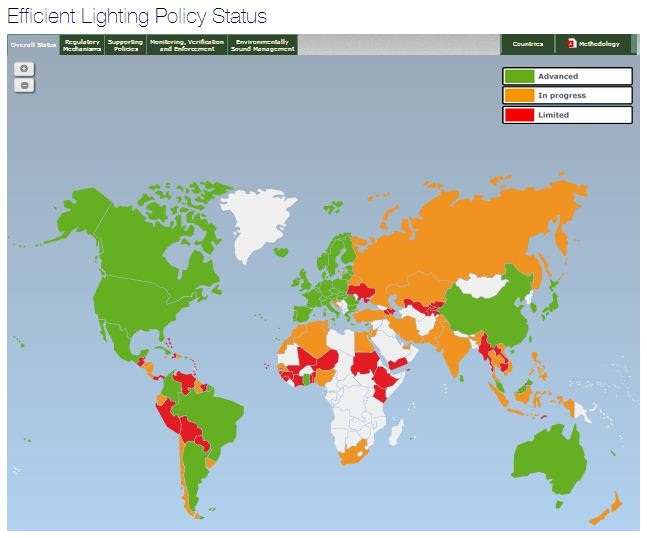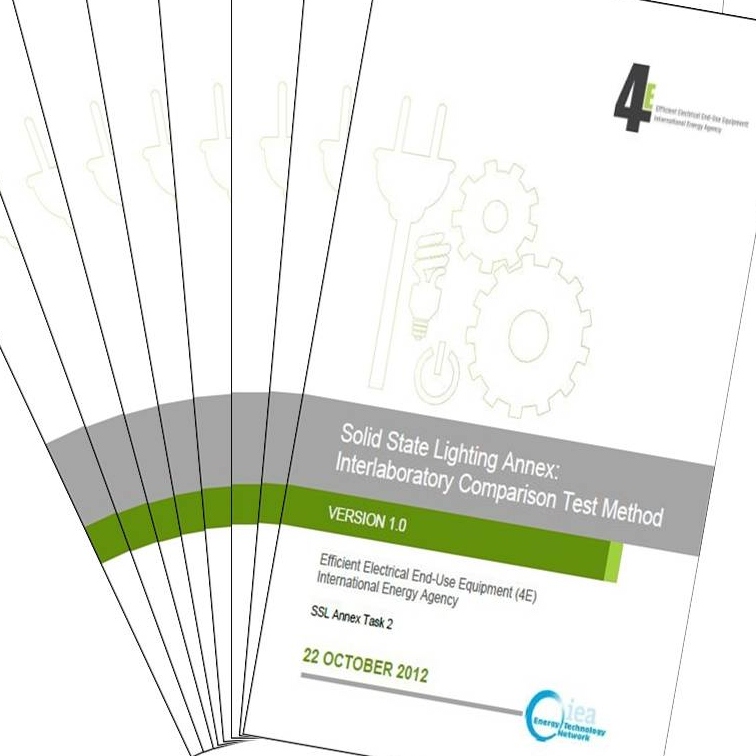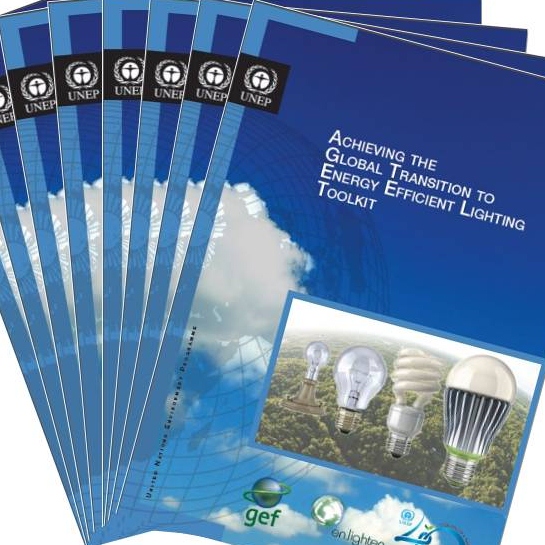In this issue we provide an update for readers on:
- Outcomes of the sixth lites.asia meeting in India in October.
- Details of the IEA 4E SSL Annex’s performance specifications and plans for inter-laboratory testing of LEDs.
- Outcomes of the September IEC maintenance meetings on lighting held in Beijing.
- Updates of several collaboration projects and environmental issues of relevance to lighting.
We also present an overview of the resources available from the UNEP/GEF en.lighten initiative to help countries move towards energy efficient lighting.
Sixth lites.asia meeting, New Delhi
The sixth lites.asia meeting brought together stakeholders from 10 countries to discuss the latest lighting policy issues relevant to the region. Held in New Delhi India on 2 and 3 October 2012, key topics discussed included:
Issues of relevance from the IEC meetings in Beijing
Feedback from the IEC TC34 maintenance meetings in Beijing in September 2012 highlighted several areas of particular interest to lites.asia members - in particular those relating to CFL and LED performance. These included:
- Information on the current draft version of IEC 60969 (Self-ballasted compact fluorescent lamps for general lighting services - performance requirements). Delegates at the lites.asia meeting highlighted concerns that the current draft contains proposals for compliance with lifetime claims and other issues that could undermine some of the goals for promotion of efficient lighting within their countries.
-
Proposals were made at the IEC meeting for the development of a Technical Specification on self ballasted CFL performance tiers which would define a range of CFL performance criteria that may be adopted by countries when developing national policy. Participants at the lites.asia meeting agreed that such a specification issued by the IEC would be valuable for future standards and labelling development within their countries. However, the proposals received a poor reception at the IEC meeting. Consequently, meeting delegates passed a resolution asking for the IEC to consider working on the development and eventual issue of performance tiers for CFLs. A copy of this can be found in Appendix 1 of the meeting report.
- lites.asia delegates were informed of the opportunity to review and comment on proposals for the standard for LED luminaire performance measurement, and for the measurement of LED lifetime in this context, prior to the next IEC working group meetings in January 2013.
- For those countries where lighting chains are significant, the availability of IEC 60598-2-20: Luminaire performance – Part 2-20: Particular requirements – Lighting Chains was noted.
IEA 4E SSL Annex
The completed performance specifications for non-directional LED lamps, directional LED lamps and LED downlighting fixtures developed by the IEA’s 4E SSL Annex were presented for consideration for adoption within participants’ countries.
|
|
The Annex also shared details of their plans for an inter-laboratory testing exercise to develop laboratory capacity and comparability of SSL results (to run between October 2012 and June 2013).
In parallel, the Annex is investigating the opportunity for these inter-laboratory comparison tests to be accepted as a Proficiency Test by accreditation bodies for laboratory recognition/accreditation for SSL testing. lites.asia members were invited to encourage laboratories within their country to participate in this exercise and to contact the SSL Annex Operating Agents for more details (Nils Borg at or Michael Scholand at
|
Since the meeting, the IEA 4E SSL Annex has formally announced the launch of the 2013 Interlaboratory Comparison of SSL product testing. All relevant protocols and documents are now available on the Annex website, including a link to the on-line application form for laboratories wishing to participate.
Global and regional support for the promotion of energy efficient lighting
The global UNEP/GEF en.lighten initiative, the Global Efficiency Lighting Centre, and the Regional Lighting Centre for South Asia presented details of the policy and technical support available to countries within the region seeking to promote efficient lighting. In particular, en.lighten noted the availability of their phase-out toolkit, revised country lighting profiles and beta copies of software to enable countries to evaluate various strategies for phasing-out inefficient lighting. More information on these tools is given in the associated article below.
Environment and health issues
India and the Philippines provided details of their plans for lighting waste management. In particular, the Philippines gave detailed descriptions of their plans for Extended Producer Responsibility (EPR) requirements including a tariff on lamp imports to finance the ultimate lamp waste management recycling and recovery.
Participants were also briefed on:
- The most recent developments in the international negotiations on a legally binding mercury convention on the transportation and use of mercury. These negotiations are approaching completion (probably in January 2013) and have the potential to have a major impact on the lighting industry. Participants were strongly encouraged to inform relevant stakeholders in their country (lighting manufacturers, recyclers, environment departments, etc.) of the potential impact of these negotiations and encourage review of proposals and provision of comment to national representatives at the negotiations at the first possible opportunity. More information on these negotiations can be found on the UNEP website.
- Information provided by the GEF/UNEP en.lighten toolkit and by the Policy Makers Guide to Mercury in CFLs to support policy makers in decisions related to mercury in lighting and other health issues stemming from the use of particular lighting technologies.
Communications materials library
At the lites.asia meeting in Hanoi, suggestions were received to develop a library of ‘communications materials’ related to lighting for domestic, commercial and industrial consumers. The intention is to include material on existing training packages, consumer information, packaging, equivalence requirements, etc., to enable exchange of experience between countries and potential harmonisation of some items (e.g. equivalence).
The specification for this library was presented at the meeting for review and suggestions were given to consider adding national policy information and/or information on the availability and capacities of laboratories within the region.
In preparation for the completion of the specification and commissioning of the library development, delegates were requested to submit any communications material available. Communications material (for example, consumer communications information, lamp packaging, training guides, awareness raising advertising, lamp equivalence guidelines, etc.) would be welcomed from other countries and any such material should be submitted to for inclusion.
Labelling supervision survey
Following the decision taken at the preceding lites.asia workshop in Vietnam, proposals were made on a collaborative labelling surveillance project involving countries within the region. The goal of the project is to establish current levels of labelling compliance and evaluate whether increased market monitoring and communications with the supply chain improves these levels of compliance. Participants were given information on the proposed project, including the outline survey methodology, responsibilities of the project coordinator and individual countries and the project timeframes. Provisionally six countries have agreed to participate in the project (Australia, Indonesia, Philippines, Sri Lanka, Thailand, Vietnam). If there is interest in participation from other countries, a representative should contact Project Manager for this exercise, Mark Ellis at , by Friday 9 November 2012.
Capacity building for laboratories
The UNEP/GEF en.lighten initiative outlined possibilities for a potential project (pending bi-lateral support from Australia) to enhance monitoring, verification and enforcement (MVE) capacity and skills. Increasing lighting laboratory and testing capacities is especially of interest to lites.asia members. Based on the results of questionnaires submitted at the July 2012 lites.asia workshop in Hanoi, provisional areas to be investigated include training for laboratory staff, professional exchanges, data sharing, laboratory accreditation and coordination of calibration of equipment. Participants were strongly urged to provide additional suggestions/clarification of MVE and local laboratory needs to Kathryn Conway, the UNEP Programme Officer in charge of the project at , to assist in project development.
Updates on National Standards and labelling and compliance activities from participants
Participants from Australia, Bangladesh, India and Sri Lanka kindly presented updates on the evolving standards, labelling and compliance processes within their countries. In addition, a representative from UL provided an update on recent developments in the qualification processes for the US Energy Star program.
For more information on the meeting and copies of all the presentations, click here.
‘Informing the Suppliers’
Delhi also saw the inaugural lites.asia ‘Informing the Suppliers’ workshop on Thursday 4 October 2012. The concept for this pilot workshop was to improve supplier understanding of mandatory and voluntary requirements in individual countries for energy efficiency and related product quality, thereby increasing the likelihood of the suppliers understanding these requirements and supplying products that comply with regulations.
Presentations were provided by Australia, Indonesia, Sri Lanka, Philippines, Thailand, China and Vietnam, followed by group questions from the audience, and finally one-to-one sessions between individual suppliers and national participants. Questionnaires completed by supplier representatives on the day indicate a consensus that the event was of significant benefit and future events are now likely.
en.lighten tools for policy makers
The UNEP/GEF en.lighten initiative was established to assist interested developing and emerging countries initiate and effectively implement programs to move towards the global phase-out of inefficient lighting products. Country support activities provided by en.lighten, focus on overcoming the technical and policy barriers related to national, regional and international efficient lighting market development.
In addition to the tailored support activities offered to countries that commit to the phase-out goal, en.lighten has developed several invaluable resources, which are freely available through their website:
- Country Lighting Assessments
- Global Policy Map
- Achieving the Global Transition to Energy Efficient Lighting Toolkit
Country Lighting Assessments are now available for over 100 countries, accounting for 95% of global lighting, and cover residential, commercial/industrial and outdoor lighting with controls. They summarise lighting related data for each country and highlight the energy, financial and CO2 savings potential of efficient lighting if used for countries that have not yet initiated the transition to efficient lighting. To see the Country Lighting Assessments that are available, please click here.
The Global Policy Map is an online resource that represents the status of efficient lighting policies and activities for countries throughout the world. It is the first tool of its kind and provides an overview of efficient lighting policies and successes, specifically in the residential sector.

The information for each country mirrors the elements of the en.lighten integrated approach and covers standards, labels, supporting policies, product quality control activities, end-of-life policies and additional information on other activities. Each country is ranked according to its policy development and gaps. A country’s readiness is colour-coded according to whether it is advanced, in progress, or limited. The ratings will be regularly updated to reflect each country’s progress in achieving a sustainable transition to efficient lighting. To view the latest rankings, click here.
|
|
The Energy Efficient Lighting Toolkit provides comprehensive guidance to countries on how to transform their markets to efficient lighting. It highlights examples of best practices in important areas, such as policy and regulation and standard development, to encourage countries to move towards efficient lighting to reap climate, energy, environmental and financial benefits.
The content of the Toolkit has been presented in practical, action-oriented terms primarily for use by those responsible for drafting policies – environment or energy departments or agencies – but also by public utilities, private sector and civil society organizations.
To download the Achieving the Global Transition to Energy Efficient Lighting Toolkit, click here.
|
Dates for your diary...
An online update on the outcomes and actions from the IEC maintenance meetings held in Beijing, China on 24-26 September 2012.
9 November 2012
3rd International Off-Grid Lighting Conference and Trade Fair
13-15 November 2012 - Dakar, Senegal
14-25 January 2013 – Milan, Italy
Next lites.asia meeting
The seventh lites.asia meeting will be held in April or May 2013 and discussions are ongoing to finalise the date and venue.


